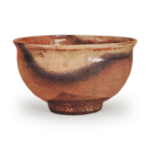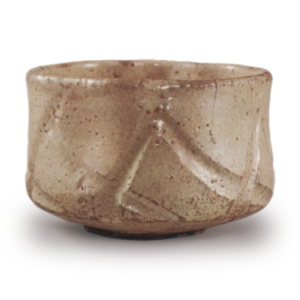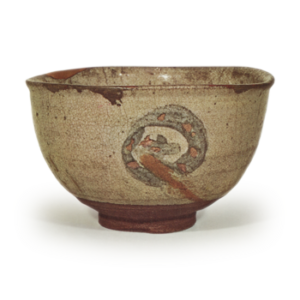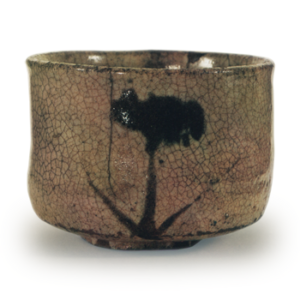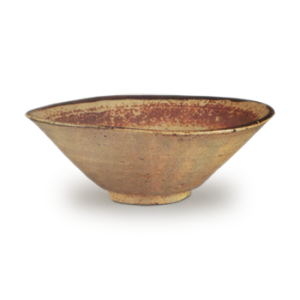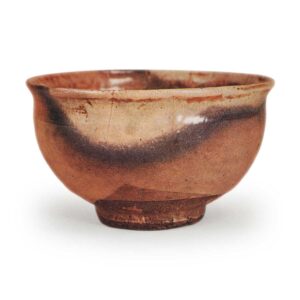
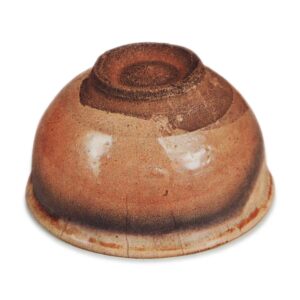
Height: 7.0 – 7.4cm
Diameter: 21.6 – 12.7cm
Foot diameter: 5.5cm
Height: 0.9cm
It is not clear when the Kumagawa tea bowls began to be classified as either Makumagawa or Onikumagawa, but it is thought that this was not that long ago, probably around the time of the Fumai era. Fumai owned the Makumagawa “Chitose” and the Onikumagawa “Hakuto” and “Murasame”, and the name Onikumagawa can already be seen in the “Unshu Meibutsu Ki” (Famous Products of Unshu).
The differences in their production are described in the Taisho Meiki Kan as
Makumagawa: These are the work of the hand of Kanto. They are pleasing in their loquat-colored glaze, and are probably all large. It is rare to find a small piece that is well-shaped. There are also new and old pieces among these, and they are probably white clay. There are also pieces with a double glaze. It is rare to find a small piece.
Onikuma River: This is also the work of Makumagawa, but it is of a lower quality.
Nowadays, people enjoy the elegance of hand-made pottery, and people admire it. It is probably all white clay, and reddish-purple clay is rare.
This type of tea-tame is all large.
The quote above is taken from a book on tea, but Makumagawa is generally large, and I have rarely seen small, tight-bodied Makumagawa. Also, the Makumagawa I have seen are mostly white clay with grayish-brown glaze, and there are few with a yellowish-brown glaze. In general, the tea bowls called Makumagawa are often of a gentle style.
In contrast, the Onikumagawa ware is described in the tea book by Takahashi Chubian as “probably all made from local clay”, but the Onikumagawa ware that I have seen is all a reddish brown clay, and so the glaze is also a reddish brown. Also, compared to the Makumagawa ware, there are many small, tightly-made pieces, and it can be said that the characteristic of this ware is that the foot ring is rather roughly made. Many of these bowls are called “Onikumagawa” because they often have purple spots on the glaze, giving them a rich appearance.
By the way, the shape and size of this bowl are almost the same as those of the “Kaga-murasaki” bowl, but the appearance is even richer. The foot, which is carved to look like a bamboo joint, has a clear “kabuto-kin” (helmet-shaped) pattern in the center, and the surrounding surface is crinkled. The tatami mat is relatively narrow, and the carving around the foot of the bowl is not very deep. The bowl is plump and well-rounded, with a full curve from the foot to the waist and then to the body. The rim is sharply curved from the neck down to the rim, and the rim is called a “tama-fuchi” (ball-shaped rim). The mirror of the tea bowl is deep and precise, and it tightens the entire inside of the bowl. The small, tight shape is also excellent, but the highlight of this bowl is the interesting variation in the glaze. It is rare to see a white glaze with a slight bluish tinge on the inside and outside of the rim, and there are no other examples like this. Around the white glaze, there is a burnt-looking substance that looks as if black smoke has drifted over it, and the other ground glaze is covered in a transparent glaze of a decayed leaf color, but the overall glaze is well-dissolved and has a smooth surface, with fine craquelure appearing. The clay is a purplish brown and is quite hard and well-fired.
The provenance is almost completely unknown, and since the Meiji era, it has been in the possession of the Akaboshi family. There are no writings on the inner box of the Shunkei lacquerware, and the outer box of paulownia wood is inscribed by Asakawa Haku-kyo, a modern scholar of Korean ceramics.
Asakawa and Akahoshi were friends, so it is likely that he asked him to write the inscription. Although it is a tea bowl without a history of ownership, it is recognized as an outstanding tea bowl in terms of its workmanship.

